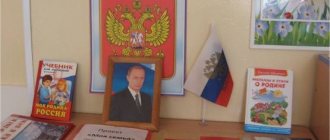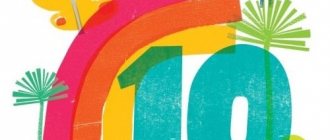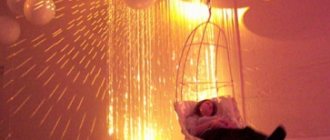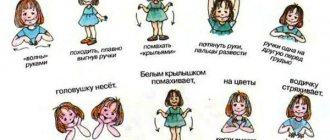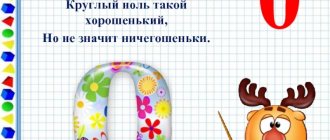Good afternoon, dear readers! Today we have an interesting and important topic on the creative development of children. Decorating fine art corners is also an art. There is no doubt that the majority of preschoolers love to draw. This is how they discover and explore the world, learn new things. You can familiarize yourself with the corresponding useful publication by the author N.G. Panteleeva. Kids enjoy drawing and being creative in art classes. Some of the children like to look at albums with paintings by artists or folk crafts. The development of aesthetic taste and creativity is undoubtedly the most important point in education.
Design of fine art corners according to modern standards (FSES)
Respected educators can become wonderful assistants in the knowledge of beauty. An arts and crafts area must be included in the group for the development of creative activity in children. And the bright and colorful design of the fine arts corner will attract children to creativity faster. I would immediately like to recommend a series by I. Lykova on creative activities in the garden. I would like to recommend the next publication , as well as this manual . For the older group, good examples of work are also given to help.
It must be remembered that according to the standard, when creating a corner, a group passport will be required. It is stored directly in the documents of the teacher or in the activity area in the group. The passport includes a description of the group, its number, the age of the children, the purpose of its creation, and the assigned tasks. A list of furniture, tools and materials must also be indicated. It is necessary to mention the number and function of posters, diagrams and other visual materials.
Modern standards of the Federal State Educational Standard dictate certain conditions so that the design of the corners of the fine art is competent. It must meet hygiene requirements. The place where the corner items are located should be well lit. It is advisable to place it near a window. Also, chairs and tables should correspond to the growth characteristics of each age group. The choice of equipment and tools should meet the needs of children.
The fact is that each age group has a certain uniqueness. And the design of the corners of the fine art should be age-appropriate. For example, children in the nursery group are going through a process of adaptation. In this regard, teachers do not need to regularly change the design of the corner. There is no need for kids to be distracted by new objects. A familiar environment without frequent innovations contributes to a softer and faster adaptation for the child.
As for the middle and older groups, the color scheme and information about art are expanding more actively. The displays in the corner can be changed more often, presenting more complex objects. It is proposed to use scissors in work under the supervision of a teacher. It is also possible to use materials such as coal and sanguine in creativity. I recommend reading this software and methodological complex .
Requirements for the activity corner in accordance with the Federal State Educational Standard for pre-school education consultation
REQUIREMENTS FOR THE CORNER OF ART ACTIVITIES IN ACCORDANCE WITH FSES DOO
Thematic zones in the group are a prerequisite for the harmonious all-round development of preschoolers. The richness of their content, together with suitable design, will allow children to gain a great experience during their stay in kindergarten. One of the favorite activities of both younger and older preschoolers is drawing, which contributes to the creative development of preschoolers. And the child will be able to find a suitable activity in the art corner, which the teacher will equip specifically for this purpose.
The purpose of the fine arts corner is to develop children’s creative potential, develop interest in artistic activities, develop aesthetic perception, imagination, artistic and creative abilities, independence, and activity.
Requirements for the creation and design of an art corner
According to the modern educational standard (FSES), the design of the fine art zone in a group must meet the following requirements.
- Compliance with sanitary and hygienic requirements. The corner is located in a well-lit place (near the window). Furniture must be appropriate for the height of children
- The equipment meets the needs of this age. After all, each age category is unique. For example, younger preschoolers are in the process of adaptation, so the teacher does not need to change the design often. Children's attention should not be distracted by unnecessary details. In addition, the art corner should contribute to the development of children's sensory skills. At an older age, conditions for self-expression are more important. Materials for creativity and aesthetic development (for example, picture albums) should be freely available to preschoolers so that they feel like “masters” in the group.
- High aesthetics. A good corner attracts children's attention with its beautiful design. The guys should feel comfortable there and experience aesthetic pleasure. “Children’s” design is important - the inclusion of game characters (pictures and dolls) and creative works of students in the design.
- Multifunctionality. The gaming environment can be modified depending on the learning situation and combined with other zones. After all, groups are not very large rooms, so every meter must be used rationally. Equipment and materials must be easily transformed to create a new game. For example, with the help of the Fine Arts corner, you can organize a role-playing game “In the artist’s workshop” (combined with the theatrical corner).
- Variability. The equipment of the zone changes periodically: new material for creativity is added, children's demonstration works and design elements are updated. In addition, conditions should be created in the corner for individual (for example, drawing, coloring pictures) and collective activities (looking at albums, didactic games).
- Safety and high quality of materials used in creating the zone. This applies to both furniture and means for directly equipping the corner (for example, dangerous items should be stored in boxes with a lid).
- Compliance with the gender principle. As you know, boys and girls have their own preferences. The teacher should take this point into account when selecting material in the art corner (in particular, offer coloring pages with cars, airplanes, robots and princesses, flowers, butterflies, etc.)
Contents of the ISO corner in the group
The most important component of the art zone in a group is its capacity.
First of all, these are directly materials for creativity, both traditional and non-traditional
- Paper of various textures and formats (A3, A4, A5).
- Paper tinted in warm and cool tones, two-color (blue top of the sheet is the sky and green is the grass).
- Colored pencils, wax crayons, felt-tip pens, gel pens, markers, charcoal, sanguine.
- Gouache and watercolor paints, brushes of different thicknesses, palettes, sippy cups, brush stands.
- Small magnetic drawing boards.
- Natural material for decorating designs (cones, acorns, seeds, sawdust, etc.).
- Devices and tools for drawing in non-traditional techniques (foam rubber, cotton swabs, toothbrushes, stamps, cocktail straws, etc.).
- Coloring books of various subjects, stencils depicting animals, plants, fruits, vegetables, cars, etc.
- Aprons and sleeves for preschoolers.
When filling the corner with materials, the age of the students must be taken into account.
So, at a younger age, colored pencils and felt-tip pens of primary colors are enough: black, red, yellow, blue and green. Further, the color range expands as children grow older. New materials are added as they are mastered (for example, watercolors, sanguine and charcoal in the older group). The same applies to materials for non-traditional art techniques (for example, after students in the junior group have mastered drawing with cotton swabs in class, the teacher places them in the art area).
Visual materials are also of great importance in the art corner. That is, in the corner there should be
- Reproductions of paintings by famous artists, demonstrating various genres (landscape, portrait, still life), portraits of painters.
- Albums on decorative and applied arts (“Gzhel”, “Khokhloma”, “Haze”, etc.). If a given topic was discussed in class, additional material on it is provided.
- Samples of toys and handicrafts. For children of primary preschool age - 2 - 3 types of folk toys (Bogorodsk toy, Semenov and other nesting dolls, Gorodets carved toy (horses), etc.). For children of middle and senior preschool age, 3 - 4 types of works of folk art are selected ( Dymkovo clay toy, works of Khokhloma and Gorodets masters, etc.).
- Folder with the best children's works.
- Album with works in non-traditional visual techniques.
- Collections of beautiful cards on various topics: New Year, Eighth of March, Victory Day, Cosmonautics Day. Children can use them as samples to create drawings and posters.
- Step-by-step diagrams for drawing popular objects (a person in different poses, a cat, a dog, a horse and other animals, birds, flowers).
- Posters on the topic of visual arts.
An integral part of the fine arts corner are didactic games of this type.
For younger preschoolers, these are simple guides to reinforce primary colors. The child’s task is to determine which colors are used in each specific drawing. Games like “Decorate Matryoshka’s sundress” are also suitable for kids: you need to match the sundress and flowers by color
In the middle group, games of the previous age become more complex and it is already possible to introduce games for the development of compositional skills and games in decorative and applied arts. At first they are simple, for example, “Place the candies in the vases.” Children must outwardly learn to distinguish products from different crafts from each other (match candies and vases)
In older preschool age, these games become more complex. For example, in arts and crafts games, the goal is to deepen knowledge. Children are invited to use cards to recreate the sequence of performing elements of folk painting. The manual may be aimed at a more detailed study of a specific painting, for example, Khokhloma. In addition, games are added to consolidate knowledge about painting genres; about perspective, horizon line, distance and approach of objects, foreground and background of the picture.
Another important component (although not obligatory) of the art corner in the group is a stand for children’s work. The child can hang his drawing there so that the teacher and other children can admire it.
An art corner organized in this way in a group will help preschoolers fully develop their artistic abilities, consolidate the material covered in class, and realize their own fantasies. The main thing is that materials and visual aids are always freely available. The bright and original design of this area is also important: after all, artistic taste needs to be developed from a very early age.
Aesthetics, beauty and creative change
We introduce beauty from an early age. The Fine Art corner should be not only practical, but also beautiful. It needs to be designed so that preschoolers can admire its appearance. That is, they learn to appreciate beauty and acquire the ability to enjoy it. The inclusion of children in the design of toys and children's works also plays a big role. This is how we begin to develop “childish” design in children.
Of course, if the objects in the corner do not change for a long time, the children will begin to lose interest. From time to time, as you study a new topic, you need to change and add materials. Also, conditions for children’s creativity must be created in the corner. Children should have the opportunity to sit next to a corner, color a picture or look at an album with creative works.
Many functions in unison
Considering that the group is a small room, you need to make the most of every meter. And the playing area can be changed depending on the initial circumstances. The tools and materials in this case should be easily modified for a new game presentation. You can also sometimes combine zones with similar themes. Let’s say that an “artist’s workshop” and a puppet theater coexist well.
Also, the main argument of the corner is its safety. Furniture, toys, materials must be of high quality and harmless. More dangerous items (sharp, cutting) should be stored in closed containers. Carrying out creative activities using tools should be carried out under the supervision of a teacher.
And another important point, of course, is to take into account the interests of girls and boys. Let there be different objects in the corner that are attractive separately for boys and girls. For example, these will be coloring pages with dolls, butterflies and coloring pages with robots and cars.
Unique design of the corner and didactic games for the art corner
For example, when taking into account the age of younger preschoolers, attention should be paid to the peculiarities of their perception. For example, a small number of flowers is enough for such kids. These are blue, red, green, yellow, black. At first, there may be pencils and markers in the corner. Then, as the kids get older, you can add other materials. Such as wax crayons, watercolors, charcoal. Or, for example, little pupils mastered drawing with cotton swabs. Then you can put them in the art corner.
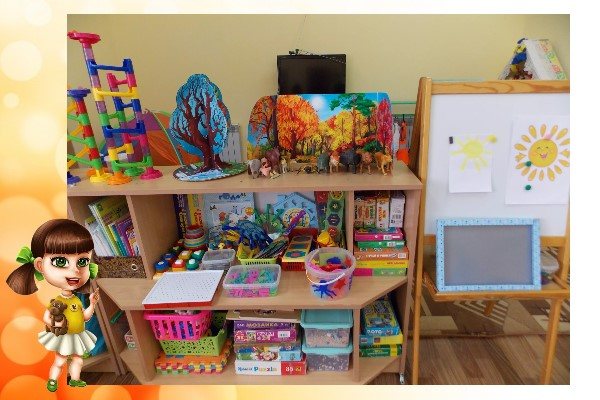
A didactic game for any age group plays an equally important role in education. Games of this nature develop preschoolers’ independence in problem solving and curiosity. Most importantly, they contribute to the ability to play in a team. Another interesting point for the teacher is that you can organize a stand for children’s work. Here children can hang their drawing or applique. Parents will also be very pleased to see the work of their children. I invite you to get acquainted with the publication , which contains examples of creative work with children.
DIY art corner. Design ideas
Larisa Savchuk
DIY art corner.
Design ideas Hello, dear colleagues! I bring to your attention an option for decorating a corner of visual activities . In the new school year, my students and I moved to a new group, and since this only happened on September 10 and the school year had already begun, it was necessary to urgently arrange the play and learning areas. There was no time to think for a long time, there was no time to make anything special, and I had to quickly design my art corner in a matter of days. And here is the result.
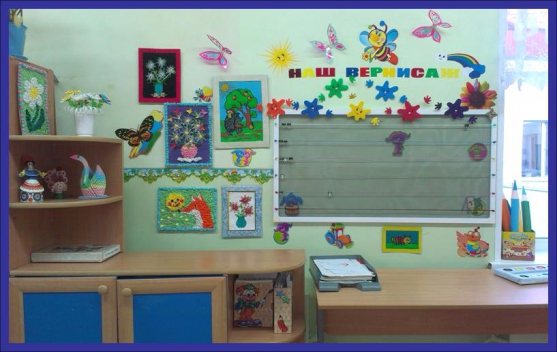
I cut out pictures from colored self-adhesive wallpaper: rainbow, sun, palette, etc.
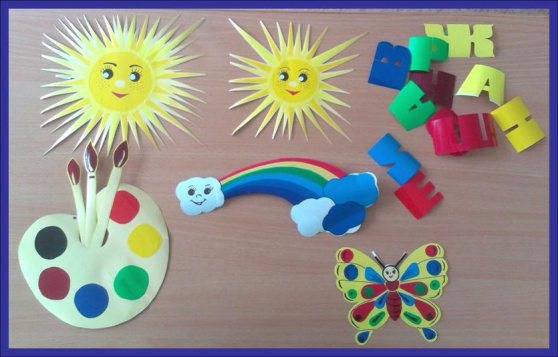
I made funny blots from thick transparent film and self-adhesive wallpaper. The idea of making blots was borrowed from
Olga Molyashcheva.
A big THANK YOU to her!
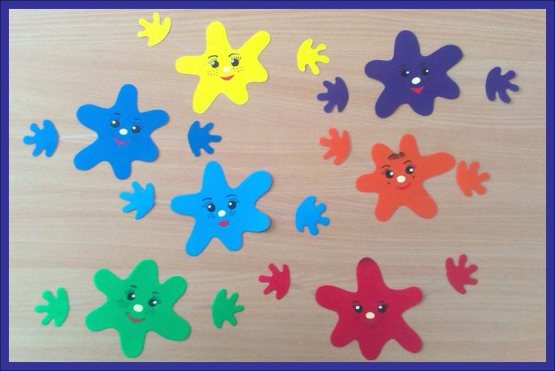
I selected various suitable color pictures. I covered them with tape and cut them out.
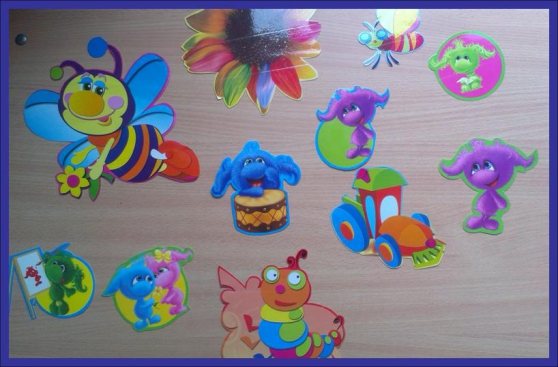
To make a stand for children's work, a mosquito net from a plastic window was useful. I inserted decorative buttons onto the sides of the mesh frame and pulled colored laces (braid, ropes)
and hung small clips.
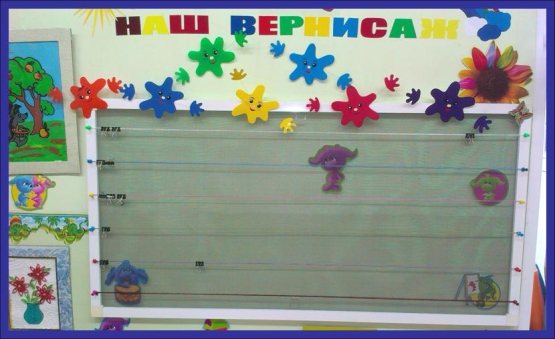
Then I designed the stand and the wall .
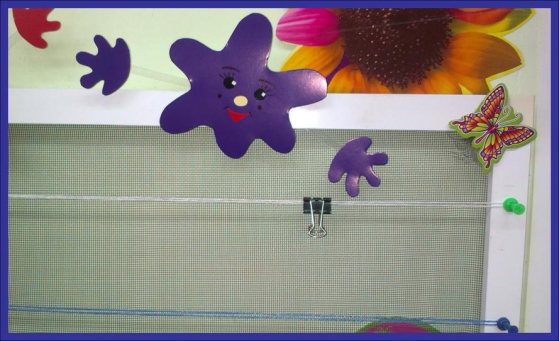
Children's works made in different techniques were placed next to the stand.
And these are paints made from a candy box.
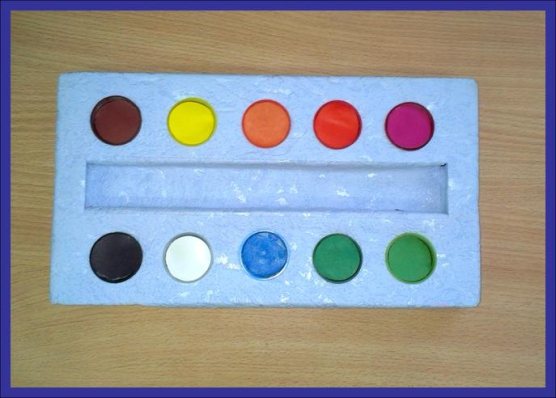
This is what the corner of visual activity and sensory development looked like when we were in the junior, middle group.
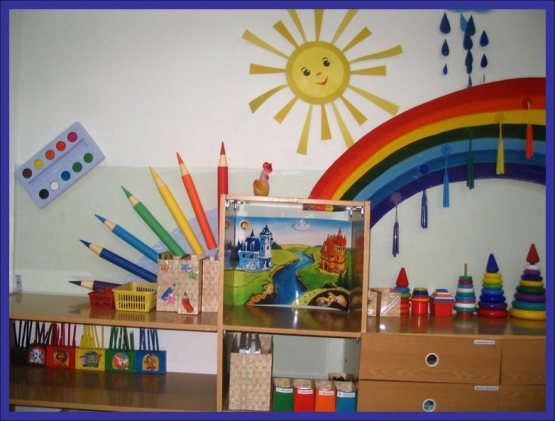
And this is how is decorated . It is made of ceiling tiles. Children like to display their work on a stand and then look at it with their parents in the evening.
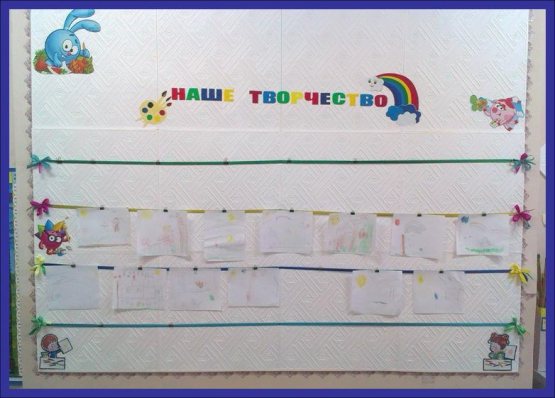
Here in the reception area there is also a sports corner . Due to lack of space, all material is placed compactly and in boxes.
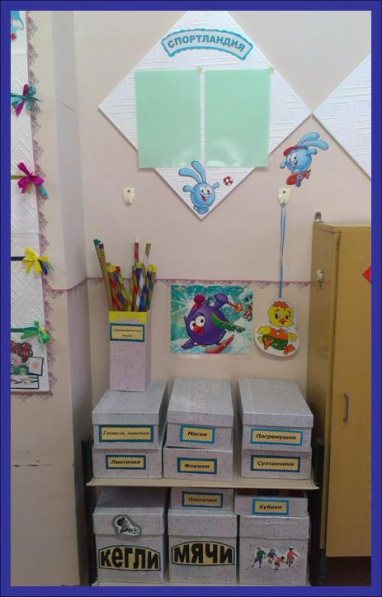
Information for parents is posted on such stands.
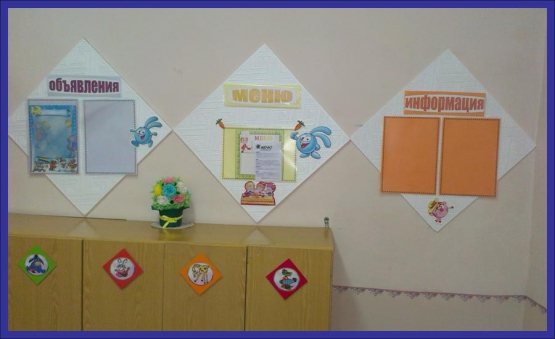
THANK YOU FOR YOUR ATTENTION!
Our group “Sunshine.” Design ideas. Dear colleagues! I would like to invite you to visit our group “Sun” and share some design ideas. I love it very much. Design of the group “Squirrel” I invite you, dear colleagues, to our group “Squirrel”. I want to share with you ideas for designing my group. I work in a new kindergarten.
Source
Visual materials in the fine arts area
Visual materials play an important role in the corner. That is, these can be reproductions of famous artists, portraits of the authors themselves. It is also recommended to post materials on applied arts. For example, these will be albums on the themes “Khokhloma” or “Gzhel”. It is good to replenish the area of fine art materials that were studied in classes with children.
It is recommended to add several toys from folk crafts to the design of the fine art corners. For example, it will be a matryoshka doll and a carved horse. Undoubtedly, postcards, perhaps dedicated to passing holidays, will be a good decoration for the Fine Art corner. Such as March 8, Victory Day, New Year, etc.
Composition of the art corner for junior, middle and senior groups
The composition of the zone will change as preschoolers mature. For the youngest, you can focus on the following materials. For furniture, a table with a lid, a chair according to age, and a magnetic board are recommended. You also need paper of different textures, cardboard, stickers, and whatman paper. Cups of pencils, crayons, and felt-tip pens are welcome. You will need aprons, trays, oilcloth tablecloths.
In the corner you can hang a calendar with reproductions of various paintings by famous artists. Every month the picture will change. You can also hang illustrations of different genres: portrait, landscape, still life. It is good to arrange, as mentioned above, templates and coloring pages for children on different topics. Albums made from children's drawings are also useful for children's attention.
Ingredient materials for the junior group corner:
- Colored pencils (primary colors are sufficient);
- Paper white and colored;
- Gouache paint (you can offer 3-4 primary colors for now);
- Brushes, stands;
- Plasticine, sculpture clay;
- Napkins;
- Silhouettes, stencils, templates for objects of simple shapes;
- Albums with illustrations corresponding to the theme of the week;
- Folk arts and crafts toys (horses, nesting dolls);
- Didactic games.
I would immediately recommend the useful guide “Sensory development of children 2-3 years old. Color. Form. Size. Didactic games and exercises for organizing joint activities between the teacher and young children. Federal State Educational Standards DO " .
Components for the corner of the middle group:
- Colored pencils in a wider range than in the younger group;
- Paper of different colors;
- Felt pens, colored crayons;
- Gouache paint (6 pcs);
- Brushes, stand;
- Sculptural clay, plasticine, napkins, tablets;
- Stencils appropriate for age group;
- Toys painted in Dymkovo;
- Natural material, loose and dense;
- Creative box with junk items;
- Schemes for making various crafts;
- Didactic games;
- Examples of Gorodets painting, Filimonov toys;
- Reproductions of paintings by artists (paintings, graphics);
- Small sculptures;
- Collection albums with illustrations on the theme of the week.
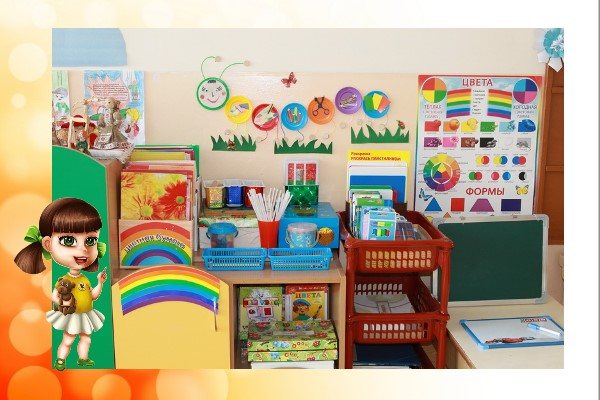
I highly recommend getting acquainted with the educational and methodological guide “Visual activities in kindergarten. Middle group" .
Components for the senior group corner:
- Paper of different structures, types, colors;
- Pencils of various colors up to 24 pcs.;
- Gouache paints, watercolors up to 13-16 colors;
- Water, jars for water;
- Palettes;
- Felt pens, wax crayons, regular school crayons;
- Brushes;
- Plasticine, materials for modeling;
- Toolkit for applications;
- Stencils on different themes;
- Examples of arts and crafts;
- Small sculptures;
- Models of products;
- Art reproductions;
- Didactic games;
- Natural materials;
- Subjects on non-traditional drawing;
- Book materials on various genres of painting and architecture;
- Albums with illustrations corresponding to the theme of the week;
- Availability of artistic handicrafts.
Do-it-yourself art corner.
Larisa Savchuk
Do-it-yourself art corner.
Corner of fine arts “Country of Creativity”
with your own hands for children of the fourth year of life .
The most important condition for the implementation of tasks is the creation of a developmental, subject-rich, emotionally comfortable, aesthetically attractive, accessible, safe and other educational environment in accordance with the needs, interests, age and individual characteristics of children.
In our group, we try to create all the necessary conditions for the development of creative expressions by all available means that encourage self-expression.
We placed a desk on the right and placed pencil cups on it, also made by us.
Also on the table is a box with stencils made of thin, colored plastic.
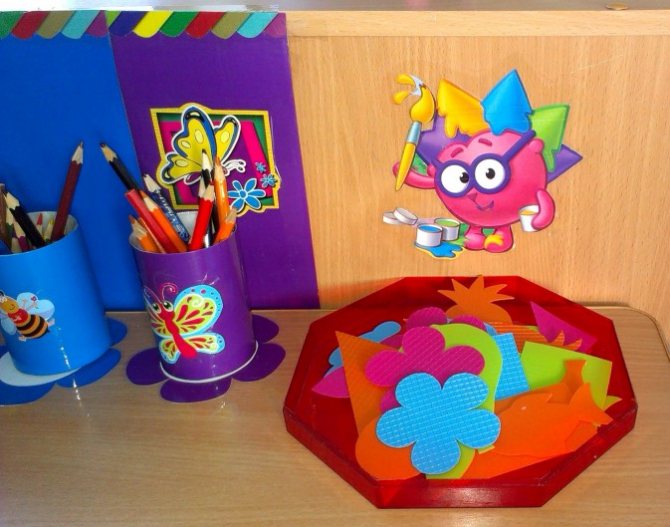
Pencil holder made from 6 identical cream boxes, glued together and covered with self-adhesive paper
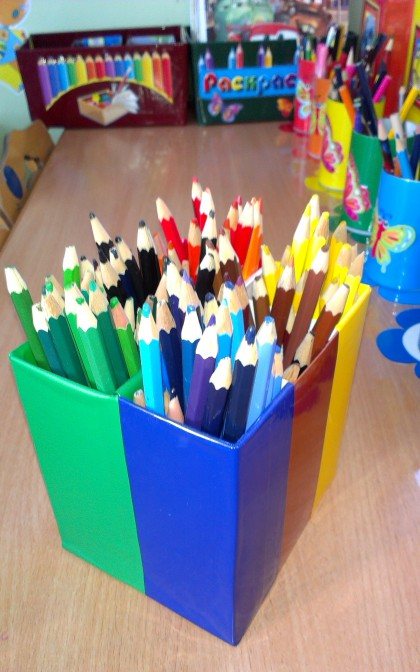
Covered boxes for coloring books, papers for free drawing
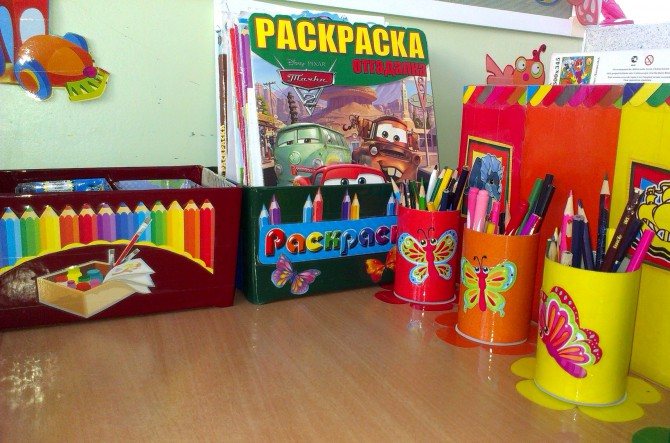
Next to the table, on the wall there is a small stand for children's work. To make it, we used a mosquito net for plastic windows, stretching colored ribbons over it.
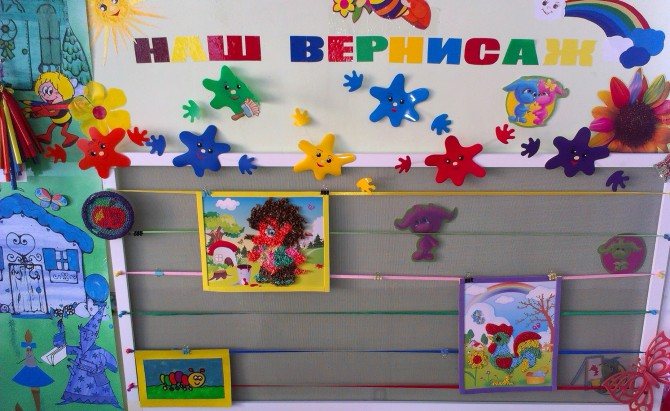
On the left side they placed a small cabinet with shelves and decorated it.
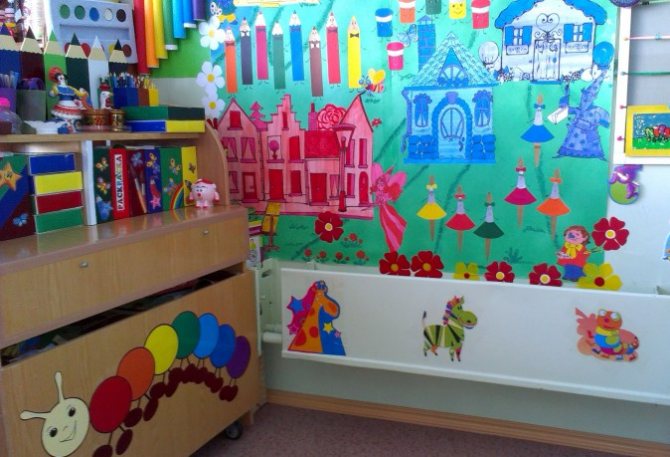
On the top shelf were placed pencils made of thick cardboard and covered with colored self-adhesive wallpaper.
We pasted over different boxes containing a variety of materials for visual arts with children.
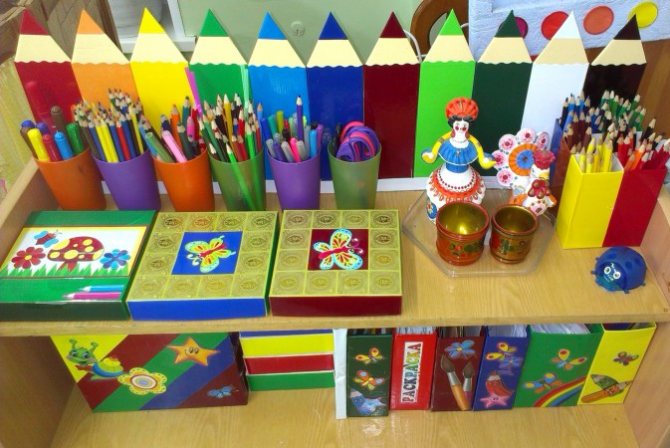
On the wall are our irreplaceable voluminous pencils, which are restored year after year.
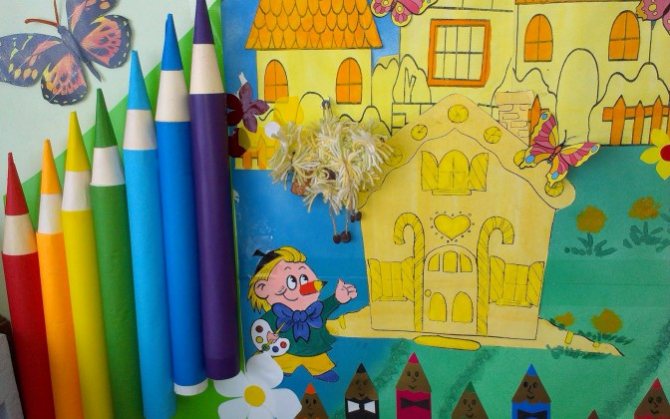
Caterpillar placed on the wall of the cabinet
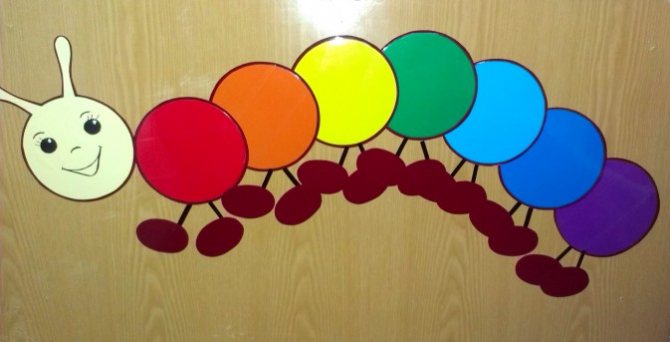
we have such a bright and attractive
And for parents in the reception area we have a large stand “Our Creativity ” made of ceiling slabs
Do-it-yourself musical corner The musical development of a child comes down not only to classes with a teacher, but also to the opportunity to play independently and play music freely. Master class “Duty Corner” with your own hands To decorate the group, we needed a duty corner. Of course, now you can buy different designs for corners, but I wanted to make it. Decorating a creativity corner with your own hands Dear colleagues and friends, I want to share the design of a creativity corner in our kindergarten in my group, made by myself. Often. Do-It-Yourself Mummering Corner Children really like the Mummering Corner. I made a dressing corner in the shape of a matryoshka doll. We also sewed all the outfits ourselves. Here is the princess outfit. Modern theater corner with your own hands To ensure an optimal balance of joint and independent theatrical activities of children in the group, a theater should be equipped. Do-it-yourself stencils for free creativity of children In our MAAM spaces there have already been many publications with different types of stencils. I also want to share the making of stencils that... Do-it-yourself theatrical corner for the younger group. I invite you to see our new corner! Let me start with the fact that the work of a teacher is creative work. And creativity is a must.
Source
Main differences by age group
Children of the younger age group show the greatest interest in drawing. To acquire drawing skills, it is recommended to purchase wax boards and appropriate dry-erase markers. You can also use rolls of wallpaper. They can be mounted on a wall or table. Kids also love to draw with their fingers and palms. For this it is better to use special paints.
For middle preschool age, it is better to organize activities in micro groups of 2-4 children. Successful introduction at this age occurs with modeling, design, and appliqué. You can also begin to introduce children to non-traditional creative techniques. For example, drawing with cotton swabs, printing with foam rubber, candles, corks, drawing with sand, collage. You can use the advice from the book by Morozova D.V.
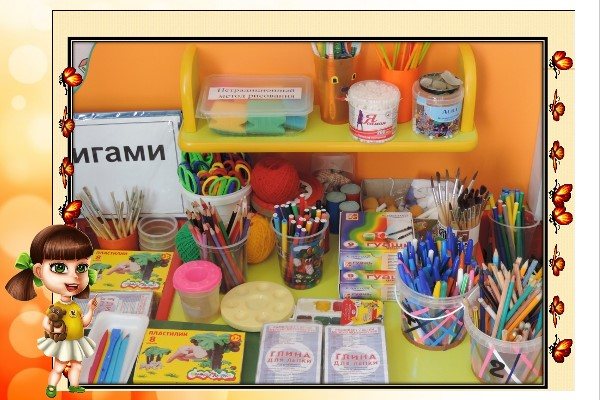
Older preschoolers are already interested in even more diverse creative and design techniques. I recommend that you familiarize yourself with the publication “Design in kindergarten. Senior group. Notes. Federal State Educational Standard" . Crafts and homemade designs become more complex due to the experience gained in new forms.
Please pay attention to the publication "Crafts for kindergarten" . It is important at this age to cultivate greater independence and self-organization. You can use the following topics: blotography, plasticineography, imprinting with crumpled paper, spraying, drawing with salt. In the preparatory group, more complex experiments can be carried out. For example, drawing on the damp surface of a leaf, blowing droplets across the leaf area.
Master class “Pencils for group design”
Zhanna Sergeevna Romashko
Master class “Pencils for group design”
The master class is intended for preschool teachers. These pencils can be used to design a group .
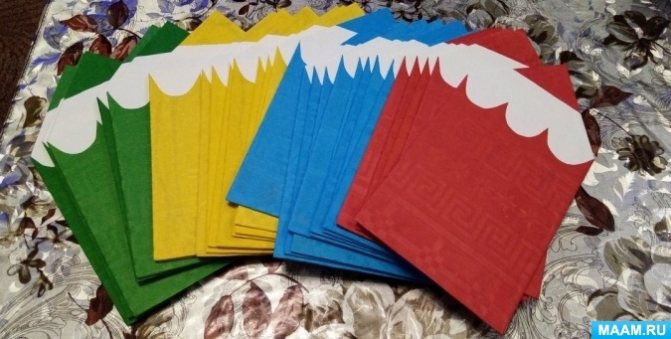
Tools and materials for work:
- pencil ;
- cut disposable tablecloths of different colors into A4 format;
- white adhesive paper;
Step-by-step manufacturing instructions:
1. Draw a pencil pattern on a sheet of cardboard and cut it out .
2. Cut cardboard templates.
3. We cut disposable tablecloths of different colors in A4 format.
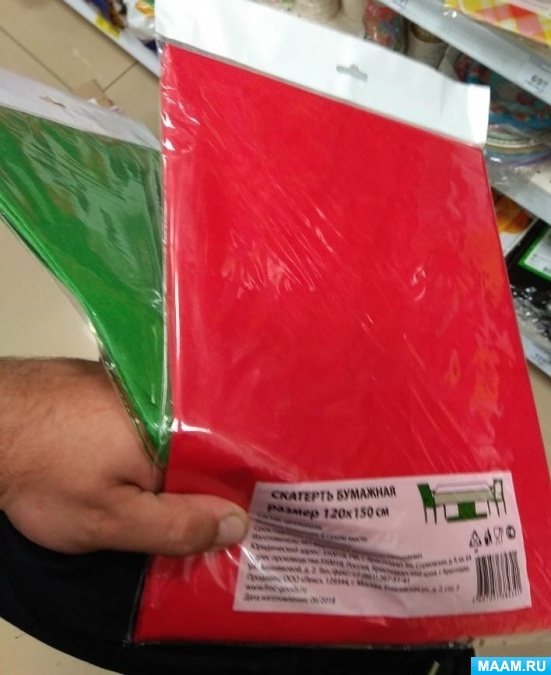
4. Mode for stripes of a disposable tablecloth (strip width 6-7 cm)
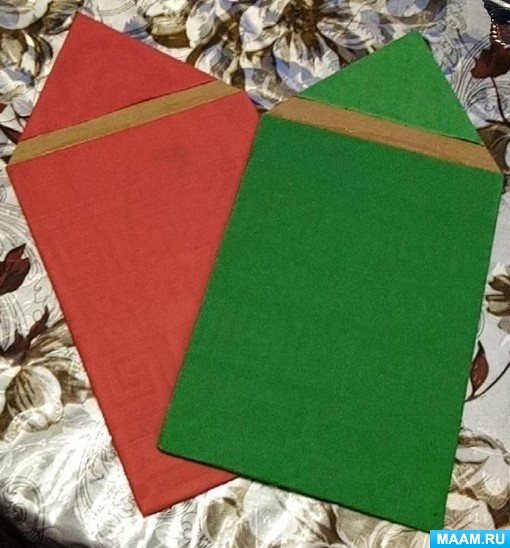
5. Glue the template at the bottom and top.
6. Cut out templates from white adhesive paper.
Any creativity is a field for experimentation, self-expression and the formation of new skills in children. interestingly designed fine arts corner will make children’s ideas come true and teach a lot.
According to the requirements of the educational standard, an activity corner must be provided in a well-lit place. Furniture and materials must be of high quality. The content of the corner should correspond to the age of preschool children, and creative materials must be changed from time to time or supplemented with new ones.
Educator: Romashko Zhanna Sergeevna
"Rain Cloud" Master class for organizing a group Forming a group in kindergarten is an integral part of the educational process. As in many kindergartens,... Paper feeders made from tubes for decoration for Wintering Birds Day. Master class For more than ten years in a row, Russian ecologists have been calling on everyone to help birds in winter. People willingly respond and meet the poor. Master class “Large paper flowers for room decoration” Master class “Large paper flowers for room decoration” An interesting idea for decorating a room for a holiday using large flowers. Master class on decorating a photo frame with flowers made of bioceramics (salt dough) “For your beloved mother” On the eve of International Women’s Day, everyone is thinking about gifts for the sweetest, most beloved and dear ones. All women in the world love flowers. Master class on decorating a wall “Flower Meadow” In spring, you really want something new in your surroundings. I offer you a voluminous spring wall decoration. First, let's make a flower template. Master class “A simple and beautiful flower for decorating cards” I would like to suggest making a very simple and at the same time very cute flower from colored paper, which will become a decoration. Master class with parents of the junior group on making three-dimensional flowers to decorate the group for a festive event. Spring is the time for new beginnings and achievements. It’s not for nothing that the New Year in Rus' used to be celebrated on March 1st. With the beginning of spring! At first. Master class “Wreaths for spring holidays and decorating a theatrical corner” I think it’s no secret that stores for preschool teachers are divided into types: 1-book store where you can buy a lot. Paper daffodils for decorating a group for spring. Master class Paper daffodils for decorating a group for spring Children of the middle group Material: white paper, yellow paper, green paper, pot, glue.
Source

